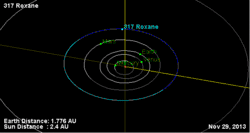317 Roxane
Roxane (minor planet designation: 317 Roxane) is an asteroid from the asteroid belt approximately 19 km in diameter. It was discovered by Auguste Charlois from Nice on September 11, 1891. The name was chosen by F. Bidschof, an assistant at the Vienna Observatory, at Charlois' request; Bidschof chose to name it after Roxana, the wife of Alexander the Great, and at first used the spelling "Roxana".[2][3][4]
 Orbit of 371 Roxane | |
| Discovery | |
|---|---|
| Discovered by | Auguste Charlois |
| Discovery date | 11 September 1891 |
| Designations | |
| (317) Roxane | |
| Pronunciation | French: [ʁɔksan] |
| Main belt | |
| Orbital characteristics[1] | |
| Epoch 31 July 2016 (JD 2457600.5) | |
| Uncertainty parameter 0 | |
| Observation arc | 124.03 yr (45302 d) |
| Aphelion | 2.4832 AU (371.48 Gm) |
| Perihelion | 2.0901 AU (312.67 Gm) |
| 2.2866 AU (342.07 Gm) | |
| Eccentricity | 0.085956 |
| 3.46 yr (1263.0 d) | |
| 39.3360° | |
| 0° 17m 6.18s / day | |
| Inclination | 1.7657° |
| 151.38° | |
| 186.926° | |
| Physical characteristics | |
| Dimensions | 18.67±1.4 km |
| 8.169 h (0.3404 d) | |
| 0.4928±0.083 | |
| E | |
| 10.03 | |
In 2008, a team identified Roxane as the closest known spectroscopic match for the Peña Blanca Spring meteorite that landed in a swimming pool in Texas in 1946. There is a possibility, therefore, that 317 Roxane is from the same parent object as this meteorite.[5]
In 2009, a team using the Gemini North adaptive optics telescope discovered a moon orbiting Roxane. The moon is provisionally named S/2009 (317) 1. It measures 5 km in diameter and orbits 245 km from Roxane, completing one orbit every 13 days.[6]
See also
References
- "317 Roxane". JPL Small-Body Database. NASA/Jet Propulsion Laboratory. Retrieved 11 May 2016.
- Lutz Schmadel (2003). Dictionary of Minor Planet Names. Springer Science & Business Media. p. 42. ISBN 978-3-540-00238-3.
- Charlois, A.; Benennung von kleinen Planeten, Astronomische Nachrichten, Vol. 132, No. 3155, p. 175
- Schmadel, Lutz D. (2007). "(317) Roxane". Dictionary of Minor Planet Names – (317) Roxane. Springer Berlin Heidelberg. p. 42. doi:10.1007/978-3-540-29925-7_318. ISBN 978-3-540-00238-3.
- Fornasier, S. et al.; Visible and near infrared spectroscopic investigation of E-type asteroids, including 2867 Šteins, a target of the Rosetta mission, Icarus, Vol. 196, No. 1, p. 119-134
- Wm. Robert Johnson, "(317) Roxane and S/2009 (317) 1, Johnston's Archive. 11 Dec 2009. Accessed 1 Jan 2012.
External links
- http://www.meteorite.com/meteorite-gallery/meteorite-pages/Pena_Blanca_Spring.htm
- http://www.minsocam.org/ammin/AM32/AM32_354.pdf
- Asteroids with Satellites, Robert Johnston, johnstonsarchive.net
- 317 Roxane at AstDyS-2, Asteroids—Dynamic Site
- 317 Roxane at the JPL Small-Body Database
